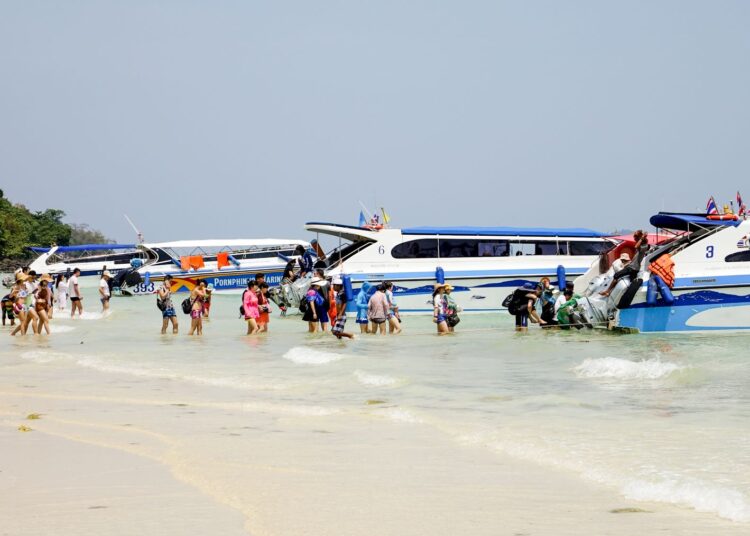Hawaii state leaders nearly passed a law last year to better safeguard Hawaii’s imperiled natural resources by raising revenues through a $40 or $50 tourist “green fee.” It didn’t pass. But proponents have hopes that this year it will clear the House and Senate and land on Hawaii Gov. Josh Green’s desk.
Both House and Senate leaders kicked off the new session this week proclaiming their general support for visitors having to pay more of a fair share to offset their impacts on the state’s natural resources. Exactly how such a fee would work, and how it might address Hawaii’s growing conservation needs as more tourists flock to an island chain that’s often dubbed the “endangered species capital of the world”, has been hotly debated for the past half-decade or so.
While tourism has many social, economic and cultural benefits, it also plays a detrimental—indeed, frequently destructive–role in the health of local environments. To begin with, tourism has long fueled over-construction and development to accommodate restaurants, hotels and tourist attractions. Other areas of harm come from how tourists use and dispose of resources—especially single-use plastics.

Many popular destinations already have a ‘sustainable tourism tax’ to fund programs and projects that conserve the environment. In Palau, for example, visitors pay $100 as part of the island nation’s “Pristine Paradise Fee” program and they must also sign a pledge, written by Palau children, to “tread lightly, act kindly, and explore mindfully.”
Likewise, Ecuador’s Galapagos Islands also imposes a $100 USD entrance fee at the port of arrival with the revenues directly used to fund “conservation, protection and management.” Yet despite this, beaches in this, one of the remotest locations on earth, are littered with plastic and garbage.
Such fees are also already common across Europe with levies in place in major cities like Paris, Berlin, Amsterdam and Rome. Venice is among the latest to institute a tax. The plan had first been announced in February 2019 and then the pandemic came along to disrupt not only those plans, but tourism itself. After considering many different versions of it, it went into effect this January 16. Mainly, there are two types of so-called tourist taxes in Venice. One is called “tassa di soggiorno” or overnight tax. The other is called “contributo di accesso”, or contribution for the access. In other words, it is a day-tripper’s tax. You pay either one or the other tax; if you choose to ignore it and you’re caught, you pay a 300 € fine. The first is calculated on a per person and per night basis at your hotel, the second is a flat 6 € per day on days when the tourist traffic is average. It goes up to 10 on heavy days. There are 4 million visitors who stay overnight, there are an astounding 20 million day-trippers.
Unfortunately, these 20 million day-trippers increase the costs of maintenance of the city but do not contribute to the increased expenses. This meant that Venetians, which are less than 50.000, had to bear the increased costs caused by 20 million non-contributing day trippers. Now this burden may be lightened on the residents.

Why should popular destinations ask tourists to pay a fee? “Tourism taxes can help us protect the places we love,” says Justin Francis, co-founder and CEO of Responsible Travel. “They can be a powerful tool and a positive thing for everyone – tourists, residents and local businesses.” The money can be used to fund infrastructure, like in the case of London’s public transport, or even reverse the damage done by crowds of visitors. In the case of Venice, the tax will lower the Garbage Tax that Venetians must currently pay which is quite high.
If we’re thinking about the effects of tourism on the environment, introducing a tourist tax is a no-brainer. If we look at the bigger picture, the question is much more complex than that. According to IATA, (International Air Transport Association) tourism taxes are counterproductive. In many cases, the revenue raised from such taxes is dwarfed by the income derived from tourism. Generally, governments increase tariffs or taxes on a given product – such as tobacco – when they intend to dissuade its consumption, not promote it. Therefore, it is paradoxical that a government would institute a tax on the one thing that contributes so greatly to their economy and in the process, discourage it.

It then becomes a question of priorities: do they opt for maximum revenue or protection of the environment? Hawaii Senate President Ron Kouchi is adamant about the “green fee” in his state: “Our residents have been clear. Visitors should be paying for their impact on our natural resources…When they are a guest in our house, they should treat our home like they would hope we treat their home when we visit.” Hawaii’s green fee would be the first in the U.S. to use the environmental license model, advocates say.
How effective the tax is to safeguard the environment is still to be determined, but Conservation International noted that visitor data show that implementing the fee did not impact visitor arrival rates. If this is true then it’s a mixed blessing: it might be good news for the economic impact, but if it doesn’t dissuade visitors, then it’s also not effective in reducing the overwhelming number of tourists that clog and pollute a destination and deplete its resources.












